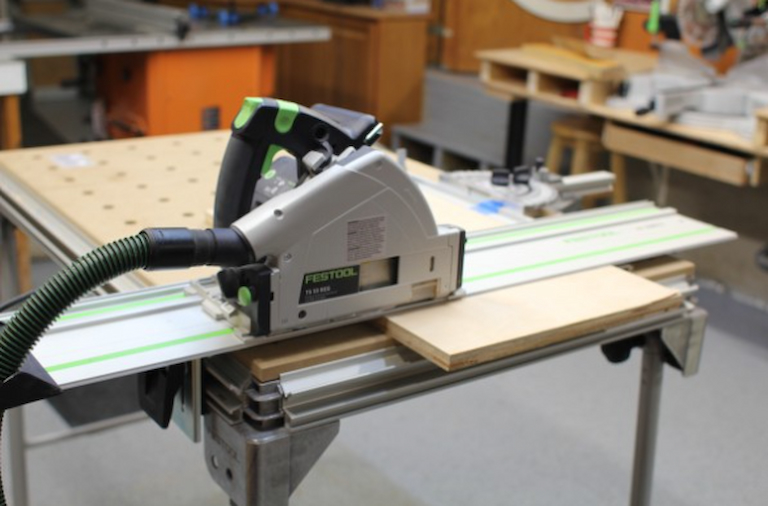The right workbench can help you create a space that supports your craft, enhances your workflow, and stands up to the demands of your projects. It can also improve your comfort, streamline your workflow, help you organise your tools, and even make your workspace safer. I’ll take you through the steps to identify the four key features you should look for when shopping for the perfect bench, so you can feel confident you’re investing in one.
Portability
It’s essential to move your setup with ease when you’re constantly shifting between tasks or spaces. You can adapt to your environment instead of being stuck working around it with the help of a lightweight mobile workbench. Whether you’re tight on space or need to clear the area once the job’s done, with this setup you can fold up, roll away, or tuck it into a corner.
You want a setup that’s light enough to move without a struggle but still solid enough to hold up under pressure. Look for features like built-in wheels or collapsible frames if you know you’ll need that kind of flexibility. And if you’re doing jobs on the go, like for mobile repairs or at different job sites, something easy to transport is going to save you a lot of hassle.
While we’re on the topic of portability, it also matters how much weight your setup can handle. You don’t want to be halfway through something only to realise your surface isn’t built to support the load. Whether you’re working on small repairs or handling heavy-duty machinery, you should know the capacity your station was built to take. Always think about the tools and materials you use most often.
For example, if you’re welding, a heavy-duty workbench is a must. This craft brings heat, weight, and a lot of sparks, so you need a solid setup that won’t budge or get damaged. A sturdy, heat-resistant surface will make your work safer, cleaner, and way more reliable. There’s a balance to be found between mobility and strength, and getting it right means you’ll have a setup that works hard and lasts longer, too.
On the other hand, for woodworking projects where you’re cutting wood with a circular saw, you’ll want a medium-duty mobile workbench that won’t wobble when you’re working. It doesn’t have to be super industrial, but it should be stable, with a solid top and enough space to lay out your materials comfortably. If you’re cutting full sheets or working on bigger builds, it’s a plus to have a setup with clamping options and room to manoeuvre.
Durability

When you’re setting up your workspace, one of the most important things to think about is how tough your setup is. Durability matters, especially if your projects are heavier or involve bulky tools. A strong, well-built surface will make sure your space stays safe, reliable, and ready for anything you’re working on.
Whether you’re drilling, hammering, sawing, or stacking equipment, look for workbenches that can take the pressure. The last thing you want is something that shifts, wobbles, or shows signs of wear too soon. And when you’re dealing with powerful tools that create vibration or impact, durability becomes even more important for safety. Here are a few reasons why you should look for a durable workspace setup:
- Takes on heavy-duty tasks without cracking or becoming unstable;
- Helps prevent accidents by staying solid and steady;
- Withstands tool vibration and weight without wearing down;
- Resists everyday wear and tear, dents, scratches, and spills;
- Lasts longer, so it’s a better investment for the long haul.
Storage Space
When you have a lot of tools, materials, and equipment to work with, having storage built into your tool workbench can make a difference. These compartments keep everything organised so you can grab what you need without wasting time hunting through piles of tools or clutter. A well-designed work area with integrated storage helps reduce mess, keeps your space tidy, and improves safety and productivity.
Make sure the storage doesn’t eat into the surface space you need for bigger projects. You want to have enough room without feeling cramped, while still having everything in reach. Think of clever storage solutions like drawers, shelves, or even pegboards on the sides for easy tool access. You might also want to consider extra space underneath for the larger gear, so it’s always available but doesn’t get in your way.
Surface Material
What’s the best material for a workbench top? When choosing the right workspace, the surface material plays a huge role in the quality of your project and your comfort while you’re working. The surface you choose should be tailored to the type of projects you’ll be doing most often.
For example, some materials can absorb vibrations better, while others might be more prone to damage if you’re working with heavy tools. You should also think whether the material could end up damaging your tools or workpieces. Here’s a quick look at some common surface materials and what they’re good for:
- Wood: A traditional favourite, especially for woodworking. It’s easy on your tools and gives you a smooth, familiar working surface;
- Steel: This is your go-to for heavy-duty tasks, industrial jobs, and metalworking. It’s durable but can damage softer materials like wood if you’re not careful;
- MDF or Laminate: These are great budget-friendly options. They provide a flat, smooth surface that’s perfect for an art studio. This kind of surface is ideal for detailed artwork, drawing, painting, or crafting;
- Rubber or Plastic: These materials are perfect for delicate work. They’re non-slip and durable, which prevents damage to fragile projects or tools.

